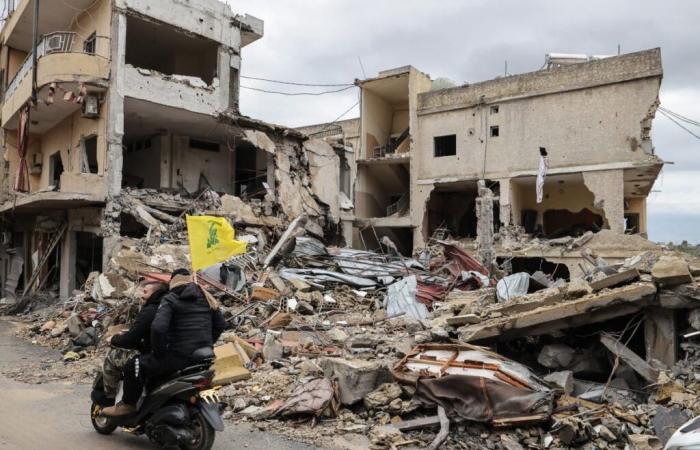L’accord de cessez-le-feu avec le Hezbollah a permis à Israël d’atteindre son objectif de découpler Gaza du Liban. Mais si l’avenir de l’Axe de la Résistance reste incertain, la stratégie d’Israël l’est tout autant.
The ceasefire agreement between Lebanon and Israel can be approached from several angles. The most important is the series of blows dealt by Israel to the Lebanese resistance, systematically targeting its leaders and operational capabilities since September. These attacks have undermined the strategy of “unity of fronts” dear to Hezbollah by demonstrating that maintaining an active military force on several fronts is proving more difficult to support than expected. Signs had already emerged that Hezbollah would be willing to consider a ceasefire. On condition that it allows it to preserve its operational capacity, to safeguard the integrity of South Lebanon and to maintain its ontological narrative of resistance.
Israel’s military, intelligence and security network will likely consider the campaign a success. They effectively ended the reign of several Hezbollah cadres from the first generation; they demonstrated the ability to infiltrate and assassinate key leaders; and they inflicted collective punishment on the “social base” from which Hezbollah draws its strength. Going forward, Israel will closely monitor who assumes leadership of the movement, hoping for a shift from figures of the past toward figures who might advocate restraint.
However, Israeli military strategy has shown its limits in recent weeks. It was typically structured around short, sharp and decisive engagements. However, Hezbollah did not collapse under the pressure of the ground invasion. On the contrary, it managed to recover a large part of its operational capacity, retaining its position as a formidable military actor. And he was able to prevent any agreement to disarm or establish a buffer zone in southern Lebanon.
Thus, the ceasefire agreement offers Israel a notable result: the decoupling of Gaza and Lebanon. However, on all other fronts, the deal failed to deliver the decisive results Israel sought.
This agreement also has important consequences for Israeli settlements located near the border with Lebanon. The rhetoric of total victory was replaced by a pragmatic desire for withdrawal, restoring a status quo ante similar to the pre-war period. Despite tactical successes, residents of these settlements remain very aware of Hezbollah’s presence and capabilities. Convincing thousands of them to return will be a challenge that will likely require financial incentives and substantial investment to restore trust and security.
On the other hand, the war has exposed Hezbollah’s vulnerabilities, which will undoubtedly influence its internal reconstruction and lead to a reassessment of its operational capabilities. Among these vulnerabilities: the organization’s exposure to Israeli and Western intelligence, the inability or unwillingness to use more of its firepower, and the cost of postponing confrontation with Israel for more than ten years. -seven years.
A crucial question will certainly drive internal debates: is Hezbollah in danger of falling back on isolationist ideologies linked solely to the Lebanese state, particularly after having lost a large part of its central leadership? Such a change could compromise its broader regional ambitions and weaken its strategic effectiveness in future confrontations with Israel or transform it into yet another sectarian party on the Lebanese political scene. It could also strengthen internal voices that advocate a status quo of non-confrontation with Israel, which would fundamentally alter its role in the axis of resistance.
Gaza remains isolated, but Israel is tired and divided
Israel succeeded in dissociating the Lebanese front from Gaza, thus putting an end to attrition attacks along its northern border. This maneuver left Gaza and its resistance isolated, facing the weight of Israeli military and political pressure. Certainly, support could still emerge from other fronts, particularly from Yemen. But the Gaza issue was reduced in the talks, weakening its negotiating power.
This decoupling could also allow Israel to advance its war plans in Gaza. But there are several reservations. The first challenge lies in Israel’s broader strategic intent: to reassert its control over Gaza for the foreseeable future. Israel’s military return to the Gaza Strip raises questions about the sustainability of such a move, the costs of governance and the long-term implications for its domestic and international standing. The logistical, political and social complexities of maintaining control over such disputed territory pose formidable obstacles, especially since Israel has failed to defeat Hamas or end its influence in the Gaza Strip.
Second, Israeli plans to expand settlements in Gaza, annex land, redraw the border, and maintain a presence in the Philadelphia Corridor and other strategic areas reflect a deeper colonial ambition. If these plans aim to consolidate territorial domination, they also carry significant risks. We will have to deal with sustained Palestinian resistance. As well as complex logistical and moral issues in imposing colonial structures. So much so that the objectives appear precarious. Moreover, the transfer of settlers to Gaza would require a degree of stability and acquiescence from the local population that seems unlikely under current conditions. Finally, these plans complicate Israel’s position regarding the return of the hostages, revealing a critical contradiction in its strategic calculations.
These contradictions are now on the verge of dominating the Israeli political landscape. After more than a year of war, fatigue and weariness set in. The discourse on total victory is being called into question, revealing signs of pragmatism. We see this in particular in the increasingly important segments of Israeli society who, especially in recent months, demonstrate the desire to end the wars in Gaza and Lebanon. This sentiment underscores the tension between the state’s expansive military ambitions and the growing desire for stability and resolve among citizens seeking a return to life without war.
Note that this dynamic takes place in the context of a right-wing government committed to ethnic cleansing and the expansion of colonies. The hostage issue has become the central concern of left-wing Israeli factions. This contradiction is expected to exacerbate internal struggles over Netanyahu’s corruption and controversial legal reforms championed by the religious Zionist bloc. Overall, the plan to redefine state identity could deepen societal divides, polarize the political arena, and intensify the ongoing battle over Israel’s future trajectory.
The unity of the fronts
The strategy of “unity of fronts”, as practiced by the axis of resistance, is based on a delicate balance between ambiguity and flexibility. It ties its constituent forces to a common strategic narrative and overarching objective while allowing each geographic context to define the scope and nature of its engagement. This dual approach – unified in vision, but localized in execution – allowed the resistance to adapt to diverse terrains and leverage specific dynamics without compromising the coherence of its broader framework.
The current war has highlighted the strengths and vulnerabilities of this strategy. Among its successes is the synchronization of multiple fronts, which has created multiple dilemmas for Israel in different operational theaters. This prolonged conflict has not only depleted Israel’s resources, but also deepened its dependence on Western powers, exposing the fragility of its hegemonic ambitions. The resistance’s ability to maintain pressure on Israel from various directions demonstrated the effectiveness of a decentralized, yet interconnected, model of struggle.
However, this strategy poses serious challenges. It reveals the tensions inherent in the geographical, ideological and social differences of the constituent forces of the resistance. These contradictions strain the cohesion of the “unity of fronts” approach, highlighting the difficulty of maintaining a united front when local realities diverge from the collective narrative. The balance between common objectives and local constraints remains a permanent test for the long-term viability of this strategy.
If the Lebanese front had been isolated from the year-long war in Gaza, the results for Hezbollah could have been significantly different. In many ways, Hezbollah paid the price for the “unity of fronts” strategy, suffering significant losses in its cadre, leadership, and operational capacity. But at the same time, Hezbollah also benefited from this interconnected framework. There were Israeli strikes aimed at decapitating the movement, targeted assassinations and even operations carried out based on intelligence such as pager attacks and intercepted communications. However, all these operations took place in a context where Israeli forces were tired by their prolonged offensive in Gaza. So much so that the impact of the attacks against Hezbollah may have been diluted.
Without the efforts of Gaza’s continuing resistance, these operations could have inflicted much greater damage on Hezbollah. Alignment with Gaza therefore not only eased Israel’s military focus, but it also provided Hezbollah with crucial breathing space to readjust its strategies. The protracted conflict in Gaza has strained Israel’s resources, its military capabilities and the morale of its reserve forces. These conditions, combined with the strategic coherence provided by the “unity of fronts” allowed Hezbollah to maintain its resilience and to maneuver politically and militarily.
Looking ahead, the trajectory of the “unity of fronts” strategy remains uncertain. Will the constituent forces retreat into an isolationist posture, attached to local concerns? Or will they maintain their broader anti-hegemonic stance in the region? The answers to these questions will shape the future of the axis of resistance and its ability to navigate the complex interplay of regional and global power dynamics.
Total victory or sufficient success?
The ceasefire agreement with Lebanon shatters Israel’s desire for total victory. It also signals the beginning of his own implosion under the weight of reality.
Israel now faces a multitude of challenges: arrest warrants pending before the ICC; fractures in its historical narrative; and the strategic paradox of seeking a decisive resolution to the Palestinian question without being able to actually resolve it, which could only result in a change in the terms and conditions of the struggle.
This in itself is one of the successes of “unity of fronts”. It forced Israel into a protracted war – one that Israel initially embraced and sought – but which ultimately has the potential to reshape its own understanding of what military power can and cannot accomplish. The ongoing conflict has tested the limits of Israeli strategy. He also exposed the contradictions inherent in his use of force as a tool to maintain Jewish supremacy in Palestine.
The Israeli narrative will inevitably undergo a subtle shift. For example, we will move from proclamations of total victory to more modest concessions of sufficient victory. However, even this complacency, this precarious rest, will give way to the persistent and inflexible antagonisms that underpin its contemporary social fabric. These contradictions will define not only its relationship with the Palestinians – with uncomfortable reminders of an unresolved history – but also its domestic management, the fractures and fault lines within it from which it cannot escape.
Original source: -
Translated from English by GL for Investig’Action






